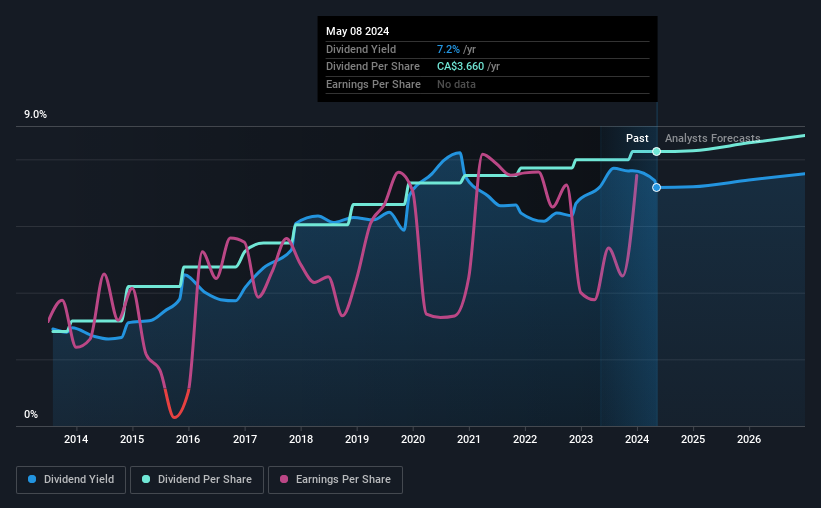Four Days Left To Buy Enbridge Inc. (TSE:ENB) Before The Ex-Dividend Date
It looks like Enbridge Inc. (TSE:ENB) is about to go ex-dividend in the next 4 days. The ex-dividend date is one business day before the record date, which is the cut-off date for shareholders to be present on the company's books to be eligible for a dividend payment. The ex-dividend date is important because any transaction on a stock needs to have been settled before the record date in order to be eligible for a dividend. Meaning, you will need to purchase Enbridge's shares before the 14th of May to receive the dividend, which will be paid on the 1st of June.
The company's next dividend payment will be CA$0.915 per share, on the back of last year when the company paid a total of CA$3.66 to shareholders. Looking at the last 12 months of distributions, Enbridge has a trailing yield of approximately 7.2% on its current stock price of CA$51.15. Dividends are an important source of income to many shareholders, but the health of the business is crucial to maintaining those dividends. That's why we should always check whether the dividend payments appear sustainable, and if the company is growing.
See our latest analysis for Enbridge
If a company pays out more in dividends than it earned, then the dividend might become unsustainable - hardly an ideal situation. Enbridge distributed an unsustainably high 125% of its profit as dividends to shareholders last year. Without more sustainable payment behaviour, the dividend looks precarious. A useful secondary check can be to evaluate whether Enbridge generated enough free cash flow to afford its dividend. Over the last year, it paid out more than three-quarters (82%) of its free cash flow generated, which is fairly high and may be starting to limit reinvestment in the business.
It's disappointing to see that the dividend was not covered by profits, but cash is more important from a dividend sustainability perspective, and Enbridge fortunately did generate enough cash to fund its dividend. Still, if the company repeatedly paid a dividend greater than its profits, we'd be concerned. Extraordinarily few companies are capable of persistently paying a dividend that is greater than their profits.
Click here to see the company's payout ratio, plus analyst estimates of its future dividends.
Have Earnings And Dividends Been Growing?
Businesses with strong growth prospects usually make the best dividend payers, because it's easier to grow dividends when earnings per share are improving. If business enters a downturn and the dividend is cut, the company could see its value fall precipitously. Fortunately for readers, Enbridge's earnings per share have been growing at 13% a year for the past five years.
The main way most investors will assess a company's dividend prospects is by checking the historical rate of dividend growth. Enbridge has delivered an average of 11% per year annual increase in its dividend, based on the past 10 years of dividend payments. It's exciting to see that both earnings and dividends per share have grown rapidly over the past few years.
To Sum It Up
From a dividend perspective, should investors buy or avoid Enbridge? Enbridge has been growing its earnings per share nicely, although judging by the difference between its profit and cashflow payout ratios, the company might have reported some write-offs over the last year. Overall, it's hard to get excited about Enbridge from a dividend perspective.
However if you're still interested in Enbridge as a potential investment, you should definitely consider some of the risks involved with Enbridge. For example, Enbridge has 3 warning signs (and 1 which is a bit unpleasant) we think you should know about.
Generally, we wouldn't recommend just buying the first dividend stock you see. Here's a curated list of interesting stocks that are strong dividend payers.
Have feedback on this article? Concerned about the content? Get in touch with us directly. Alternatively, email editorial-team (at) simplywallst.com.
This article by Simply Wall St is general in nature. We provide commentary based on historical data and analyst forecasts only using an unbiased methodology and our articles are not intended to be financial advice. It does not constitute a recommendation to buy or sell any stock, and does not take account of your objectives, or your financial situation. We aim to bring you long-term focused analysis driven by fundamental data. Note that our analysis may not factor in the latest price-sensitive company announcements or qualitative material. Simply Wall St has no position in any stocks mentioned.

